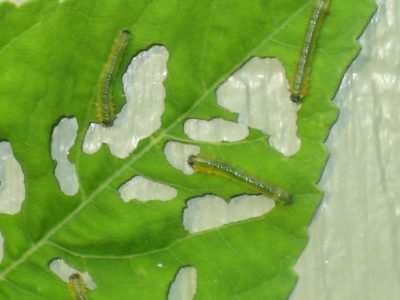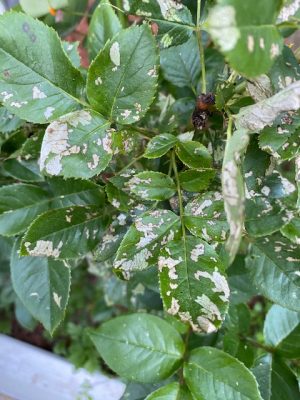By Dawn Pettinelli, UConn Home & Garden Education Center

Gardeners know that amidst the promises of each new growing season come its challenges, usually in the form of weather or pests. A common insect pest this time of year are sawfly larvae, which feed on some of our favorite plants including roses, azaleas, perennial hibiscus, dogwoods, and some pines. If populations are high, significant damage can occur.
Sawfly adults are small, short-lived insects slightly resembling wasps to which they are related but their waists are generally thicker. Their ovipositor (egg-laying appendage) is somewhat saw-like in appearance, hence their common name. Eggs may be laid singly or in groups.
Larvae look like small caterpillars but there is a distinctive difference between caterpillars in the Lepidoptera family that transform into butterflies and moths, and sawfly larvae in the Hymenoptera family. Larvae in both families have numerous pairs of legs. From the head, the first three pairs are thoracic legs that correspond to an adult insects’ three pairs of legs. Count the number of fleshy leg pairs (pro-legs) after that. Caterpillars have 5 or less pairs while sawfly larvae have 6 or more.

Check your rose bushes for rose slugs, a common name for at least 2 species of sawflies whose larvae may be feeding on your plants. One is thought to be native to the U.S. and the other accidentally introduced from Europe. Both were noticed as pests in the Boston area over 100 years ago and do similar damage to rose foliage.
The small green caterpillar-like larvae that may be ½ to ¾ inch long depending on the species skeletonize the leaves and only the veins remain. They can feed for several weeks if not controlled and move to the undersides of the leaves during the day making them hard to spot. One or two generations may be present each season, again depending on species. Mature larvae will pupate in the soil below plants, where they overwinter and will reemerge the following spring.
Hibiscus sawflies feed on members of the mallow family with the most common one in this area being the large-flowering perennial hibiscus. The green larvae are small, and also can be found on the undersides of leaves where they often go undetected until large leaf areas are consumed.
There are at least 3 species of sawflies that feed on azaleas in this area. The small green larvae have tannish heads but are hard to spot at first as they feed on emerging foliage. Keep an eye out for foliar feeding at the edges of the leaves. The larvae are less than ½ inch in length and feed until late June or early July. There is only one generation per year and these larvae will also drop to the ground to pupate and overwinter in the soil below plants.
Pine sawfly species seem to prefer Mugo, Scots and red pines although they can feed on others. Some are inadvertently introduced pests like the European pine sawfly. Since they were first noticed around 1925, they have become widespread pests. The larvae may be up to an inch long and is grayish-green with mostly darker parallel stripes. Red-headed pine sawfly larvae have red heads as the name indicates but has a yellow body with black spots.
Pine sawfly adults typically lay groups of eggs so multiple larvae hatch and feed in groups. They have a very distinctive defense mechanism when disturbed. Most curiously they rear up and ‘wave’ as you wave your hand over them. This does discourage insect, avian and vertebrate predators, at least to some extent.
Dogwood sawfly females can lay more than 100 eggs on the underside of their preferred grey dogwood host plant. Larvae can consume the whole leaf as they mature leaving only the large midvein. Young larvae are translucent and yellowish but develop black spots and become covered with a white powdery coating as they mature. Their appearance can make a gardener think there are two species of insects attacking plants rather than one. When mature, the larvae seek out an overwintering location with rotted wood on the ground being preferred.
Regardless of which species of sawfly is attacking your plants, options for control include hand picking, insecticidal soap, Spinosad or other insecticides labeled for sawflies. While Bacillus thuringiensis (BT) can be used for caterpillars in the Lepidoptera family, like cabbageworms and Eastern tent caterpillars, it does not work on sawflies.
If you have questions on identification or control of sawfly larvae or any other gardening questions, feel free to contact us, toll-free, at the UConn Home & Garden Education Center at (877) 486-6271, visit our website at www.homegarden.cahnr.uconn.edu